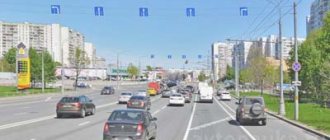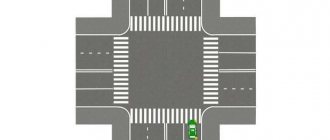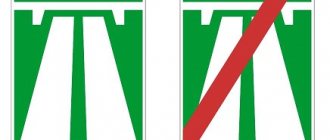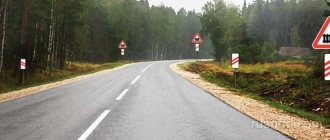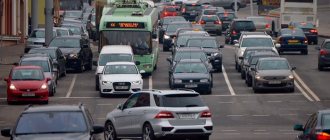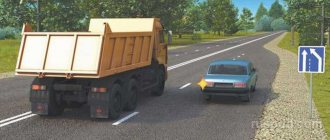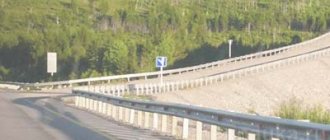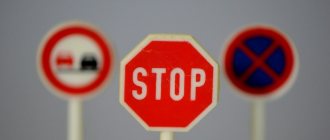In which directions are you allowed to continue driving?
| 1. | Only to the left. |
| 2. | Straight and left. |
| 3. | To the left and in the opposite direction. |
An additional section with a signal turned on in the form of a green arrow, a sign “Driving directions along the lanes” and markings 1.18 allow you to only turn left from the right lane. Traffic is directly prohibited by a red traffic light, and turning is prohibited, since the rules require turning only from the leftmost lane. Turning right is prohibited at any signal.
Amounts of fines
Violation of the “Driving in Lanes” sign is punishable by a fine. Its size depends on the circumstances of the offense committed. The minimum penalty amount is 500 rubles. According to Article 12.16 of the Administrative Code, the amount of penalties and the list of circumstances for ignoring the rules of the DD correspond to the following list:
- movement along dividing markings – 500 rubles;
- changing lanes between lanes, which is not accompanied by turn signals - 500 rubles;
- overtaking where it is prohibited by a sign - 1,500 rubles;
- changing lanes across a solid line entails a fine of 500 rubles for violating lane markings;
- driving in oncoming traffic - 1,500 rubles, if the motorist did it while overtaking - 5,000 rubles;
- Ignoring the traffic mode indicated on the sign is fraught with the imposition of a fine equal to the sanction imposed for exceeding the established speed:
- making a turn where it was impossible to resort to this maneuver entails a fine for turning outside your lane of 1,500 rubles.
The law also provides for penalties for driving into a lane equipped for other vehicles. So, for going on a path for cyclists you will have to pay 2,500 rubles, and for a road that is reserved for buses - 1,500 (for cities of federal significance - 3,000 rubles).
Which trajectory do the Rules allow you to make a left turn?
| 1. | Only according to A. |
| 2. | Only according to B. |
| 3. | For any reason. |
The “Lane Directions” sign allows for left turns at this intersection from the middle and left lanes. Therefore, you can turn left either by moving into the leftmost lane in advance, or by continuing in the middle lane, i.e. turning is allowed along any of the specified trajectories.
You intend to turn left. Your actions?
| 1. | Give way to the tram and, making sure that your path does not intersect with an oncoming car, make a turn. |
| 2. | Go through the intersection first. |
A green traffic light gives the right to move to all vehicles. But when turning left, you must give way only to the tram, since your paths will not intersect with an oncoming car.
Driving in lanes at an intersection is not the only traffic regulation requirement
Organizing traffic at intersections is the job of special road services, which, based on traffic rules, install the necessary priority signs and traffic lights. It is worth noting that the effect of road signs before the intersection remains valid only in situations where it is a speed limit sign, a sign prohibiting parking, or signs that define a parking area or other signs that have a beginning and an end to the area of validity.
In addition, you need to know that the rules strictly prohibit reversing at an intersection, because this will create a lot of interference for other participants. In addition, it must be remembered that traffic at intersections is carried out in different directions: turn right, left, go straight and others that are allowed by the rules. So it won’t hurt to look around, even if your traffic lights are green at the traffic light, or you are on the main road. Often, due to the presence of many directions, inexperienced drivers can get confused and drive completely against the rules.
It is worth mentioning two fundamentally different types of road intersections that define the 2013 traffic rules; intersections can be regulated and unregulated. The first include sections of roads that are equipped with traffic lights or are constantly attended by a traffic controller. Considering the modern situation, the first option for regulating the intersection is more popular, but the second also has a place in difficult situations. In those controversial cases, when the traffic light is turned off or there is no traffic controller, then movement and maneuvering must be done in accordance with the priority signs that are found at any intersection.
An uncontrolled intersection is defined by traffic rules as a section of road intersection that is equipped with appropriate markings or priority signs.
In which directions are you allowed to continue driving?
| 1. | Only to the left. |
| 2. | Only in the opposite direction. |
| 3. | To the left and in the opposite direction. |
An additional section with a green arrow signal on, a “Lane Directions” sign and marking 1.18 allow you to turn left or make a U-turn from the left lane.
What does it mean to determine the number of lanes by markings?
Initially, road signs and corresponding markings ensure the functioning of full traffic and should not contradict each other. But sometimes, due to some circumstances, a contradiction arises between them and it is not clear what to do in this case. To navigate well in such situations, the driver must know that the symbols are:
- temporary (set for a specific period of time on the highway and directly related to repair work);
- permanent (valid without temporary restrictions on a certain section of the road and can sometimes be replaced with similar temporary signs of adjacent significance).
The most obvious difference between these signs and the markings in terms of stripes is the chosen color: the temporary sign is yellow, and the temporary marking is orange. In addition, they are used only for a strictly designated period for this purpose, after which they are finally removed.
How to determine the number of lanes without signs and markings
At first glance, accurately determining the number of lanes is not difficult, but this is only with the existing markings and good visibility. If the road is not noticeable, for example, under the snow, then it is necessary to conditionally divide the roadway into two equal halves and move to the right of the middle. In any case, road markings may not be visible to the driver.
It is also worth remembering one more basic rule: if there is a central solid line on the road dividing the highway in half, then it is prohibited to cross it, since in practice such a maneuver will impede traffic in the oncoming lane and endanger all other participants (other drivers, passengers and pedestrians).
How does the rebuild happen?
In practice, changing lanes can only be done when turning to the right, to the left, and also in case of a U-turn. Then the driver must change lanes right before approaching the intersection in order to make a U-turn from the permitted lane.
The text in the Traffic Regulations 2021 directly indicates the following conditions: let all cars that are moving straight ahead pass without changing lanes and, in addition, give priority to cars that are changing lanes at the same time as you and moving on the right side. It should be taken into account that when changing lanes, accidents often occur for the following reasons:
- The driver inattentively looks in the rearview mirrors and does not notice objects moving behind.
- The driver does not fit into the general flow in the adjacent lane, picking up too low or high speed.
- They forget to turn off their turn signals and other road users are unable to guess their intentions.
By thoroughly knowing and observing such simple requirements, every driver can freely move along any highways without any problems or incidents, without violating the traffic rules on the lanes.
You intend to turn right at the intersection. What should you do?
| 1. | Change over to the right lane, then make a turn. |
| 2. | Continue in the second lane until the intersection, then turn. |
| 3. | Both methods are possible. |
The “Lane Directions” sign informs that at this intersection, turning right can be made not only from the right, but also from the left lane. This means that you can turn right, either by moving into the far right lane in advance, or from the second lane.
Signs throughout the intersection
These signs also belong to the category indicating directions of travel at an intersection. This type is installed before the intersection of roadways and extends throughout the entire intersection. Most often, this sign can be found before a roundabout. According to the traffic rules, drivers driving in the lane are required to follow its instructions. Thus, it is assumed that when entering from the right, the driver must finish driving along the lane at the intersection also on the right side, and when entering from the left, exit from the left. These instructions usually confuse many drivers. Therefore, the rules of passage at the intersection are determined by the drivers themselves. In order not to create an emergency situation, you should remember several traffic rules: If the markings are not a solid line, then the driver has the right to change lanes at any time. Exit from the roundabout is carried out exclusively on the right side. Sometimes exit is regulated by signs 5.15.1 and 5.15.2. If there is a “Give Way” sign in front of the roundabout, if you do not comply with this requirement, then a fine of 1000 rubles will be included in the traffic violation protocol.
Signs indicating the start of the lane
Road signs of this category warn of the formation of an additional traffic area. You should carefully follow the current instructions, as many of them limit driving in the lane to the maximum speed. Violating the speed limit may result in a fine ranging from 500 rubles to 5,000 rubles, depending on the speed limit.
End of lane sign
A sign called “End of Lane” is installed to indicate the end of the roadway and the further narrowing of the roadway. When changing lanes when the road narrows, they are required to give priority to traffic moving on the left. If a violation of this traffic rule is established, the driver is issued a fine of 1,000 rubles.
Lane direction sign
This index has a similar name and has already been discussed. It detects traffic in a lane when the number of lanes on one side exceeds the number on the other. The main purpose of the sign is to regulate the direction of travel of vehicles along a section of the road and to facilitate driver orientation on complex road surfaces. These signs may also indicate restrictions on a certain section of the roadway. Most often, the traffic is in the truck lane. If this traffic rule is violated, drivers driving cargo vehicles will receive a fine of 500 rubles. When driving a truck further than the second line of the roadway, the fine increases to 1000 rubles.
